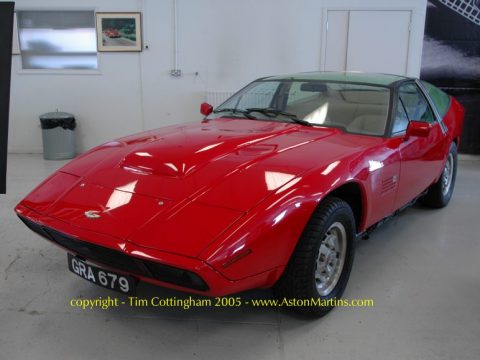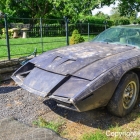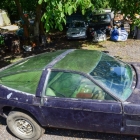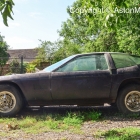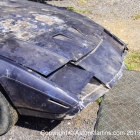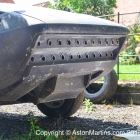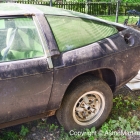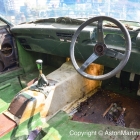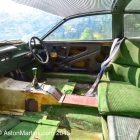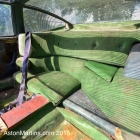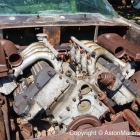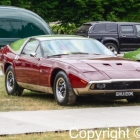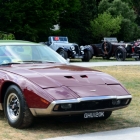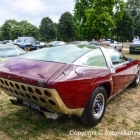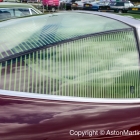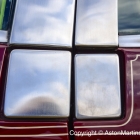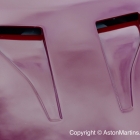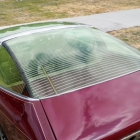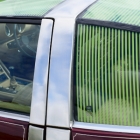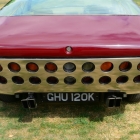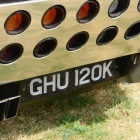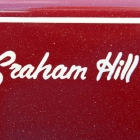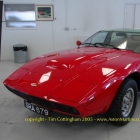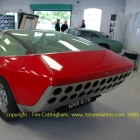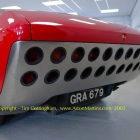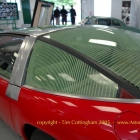The Motor Show Sotheby Special
The finished rolling concept, chassis number DBSV8/10380/R, resplendent in dark blue with exquisite gold pin striping was unveiled as a centrepiece of the Montreal Motor Show in January 1972; a couple of months later it also appeared at the 1972 Geneva Salon. Motor Magazine must have been impressed by the car as they chose it for the cover story of their 15th January 1972 issue.
Based on a DBS V8 chassis, the bodywork was constructed from glass-fibre and above the waistline is totally formed from Perspex supported on a tubular frame of Reynolds 531 (as also used on the very best bicycle frames at the time). The rear panel was made of a single sheet of satin stainless steel with 22 holes cut into it for the rear lamps. The harder the driver braked, the more lights were illuminated. The headlamps are hidden by a pair of pneumatically operated panels that drop down when the lamps are in use. Also of note is that the car has a single sideways rear seat which must make the Ogle the only post war three seater Aston Martin.
The original ‘Sotheby Special’ motor show car was partially stripped for parts and put into store; never road-registered, it has been hidden from view for over 40 years. We have been very privileged to see and photograph this car with the kind permission of the owner.
The fibre-glass coachwork is in incredibly good condition; far thicker and more rigid than expected. The period 1970’s green corduroy interior has lasted well and could easily be saved only needing a light clean. But the jewel in the crown is the 1969 vintage prototype 5,340 cc V8 engine together with it’s correct 5 speed ZF manual gearbox.
The Road going Sotheby Special
Aston Martin also provided Ogle a second chassis, DBSV8/10381/RC, which did became a fully finished road car in May 1972, also painted in the same dark blue and gold ‘Sotheby’ colours. The car toured the country to promote the brand but ‘Sotheby’ Cigarettes failed to take off and by the following year, the car was repainted in the Imperial Tobacco ‘Embassy’ cigarette brand colours of white with a logo of red triangles. During this time, it was not unusual to see the car at top race meetings as Imperial Tobacco were a major sponsor of the ill fated Embassy Hill Formula 1 racing team.
The road car has many detail differences to the show car – most noticeably is that it has its windscreen, side and rear windows are Triplex glass with it’s special lined coating to reduce glare from the sun.
The ‘Sotheby Special’ road car, GHU120K, has proved very elusive to me but was seen in public for the first time in many years in the timeline for Aston Martin Centenary Celebration at Kensington Palace in July 2013. It is held in a private collection in the UK.
The ‘replica’ 3rd Ogle
Following an appearance on the BBC TV programme, Tomorrows World, a wealthy lady was determined to own an Aston Martin Ogle of her own and, after much persuasion, she was able to obtain an AMV8 rolling chassis from AML and convinced Ogle to build a 3rd car. GRA679 was reputed to have cost £28,750 when the standard car was priced at only £8,749. This particular car, the only one of the three built with an automatic gearbox (pictured below) has had the original fuel injection system removed and replaced with Weber carburettors. This has necessitated a bonnet bulge to give the extra height which would not have been there when the car was first shown. The car is featured in the sales catalogue for the Christies auction at Retromobile, 12th February 2005 and is now part of a private collection overseas. The images below showing GRA679, were taken in June 2005 at the Aston Martin Restoration Centre in Newport Pagnell.
The problem with a car such as the Ogle that so closely follows fashion, is that it can start to look outdated very quickly – and I’m afraid that it does look very ’70’s’. Opinion has been that the Ogle was a lighter and faster car than the standard DBS V8 by having a fibreglass body although figures from the promotional literature show the Ogle to be actually a little heavier. Still the best car car ever conceived and built in Letchworth.
Back in 1965, Ogle Design was also responsible for design concept interior on a single DB5. Other cars of note also designed by Tom Karen are the Reliant Scimitar GTE and the Bond Bug. Tom Karen was also responsible for the inspiration for the iconic Raleigh Chopper cycle.



